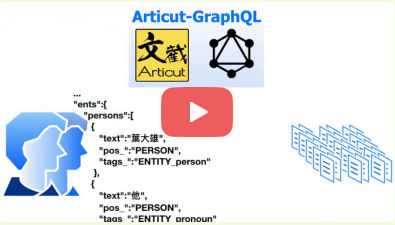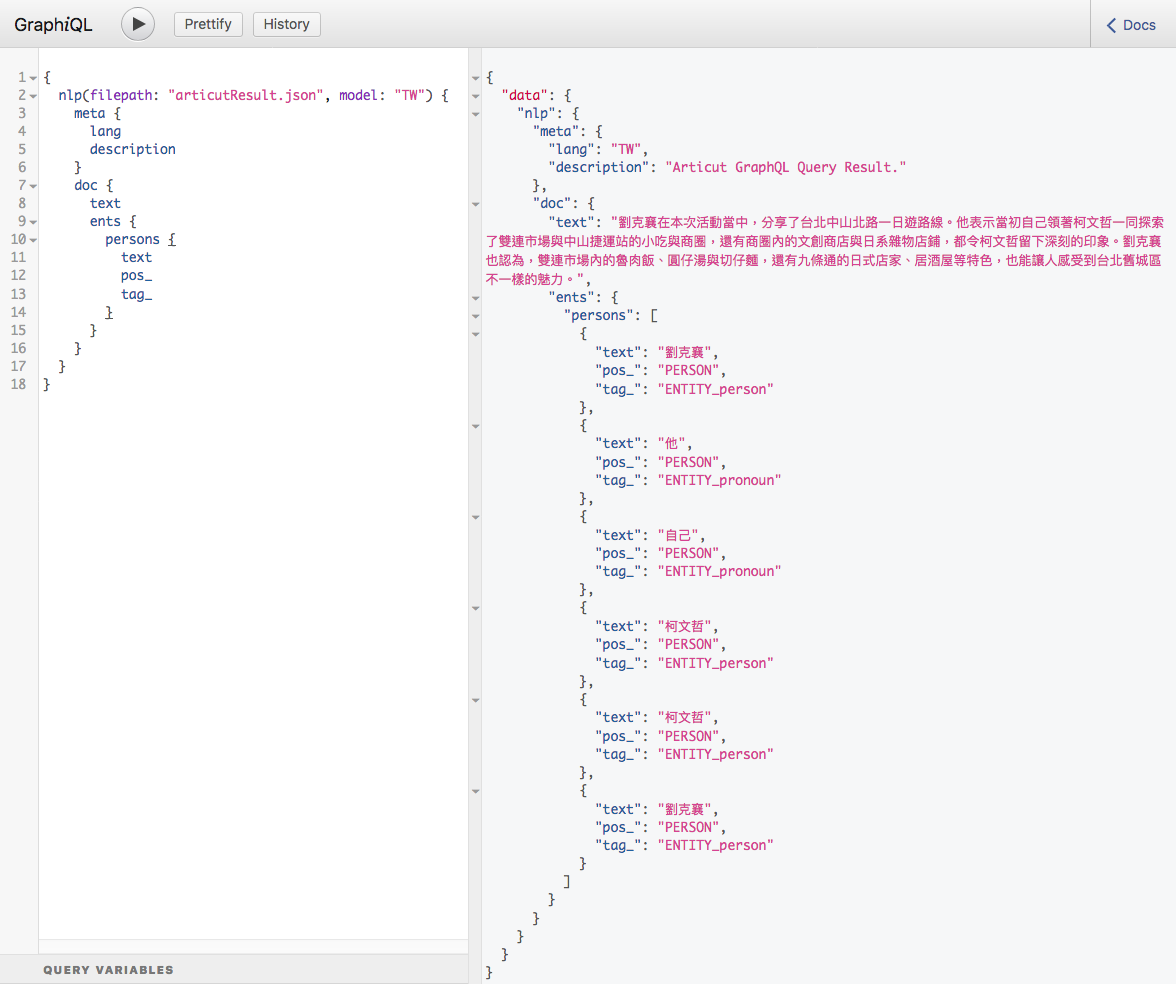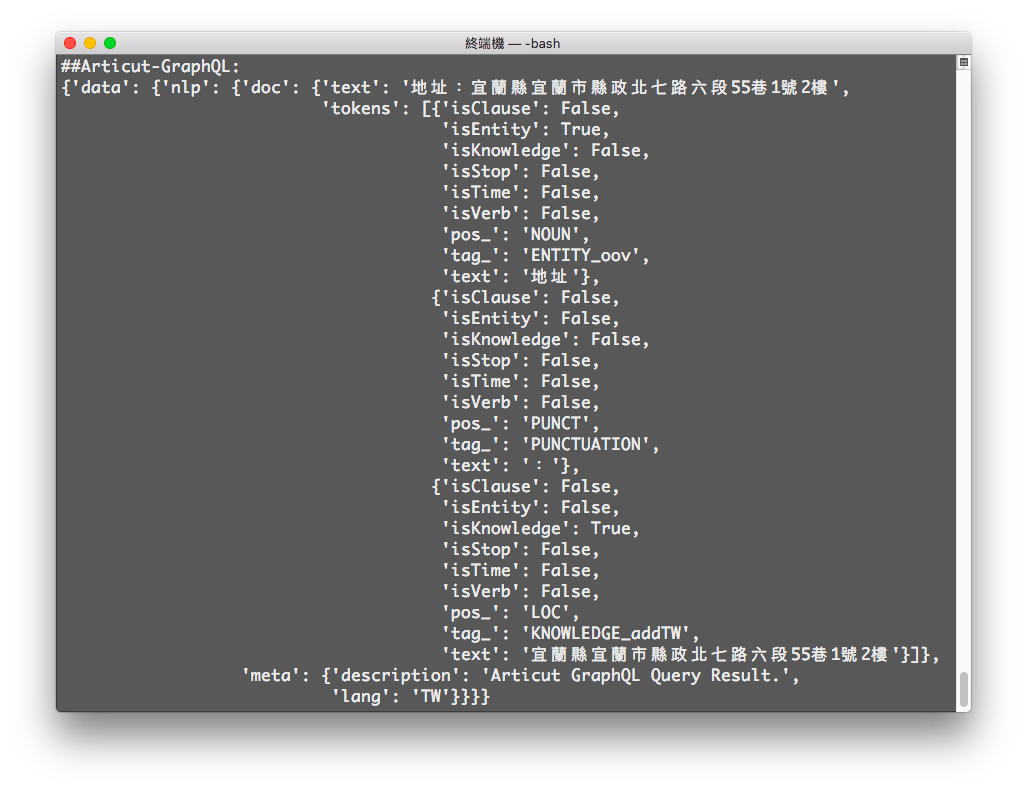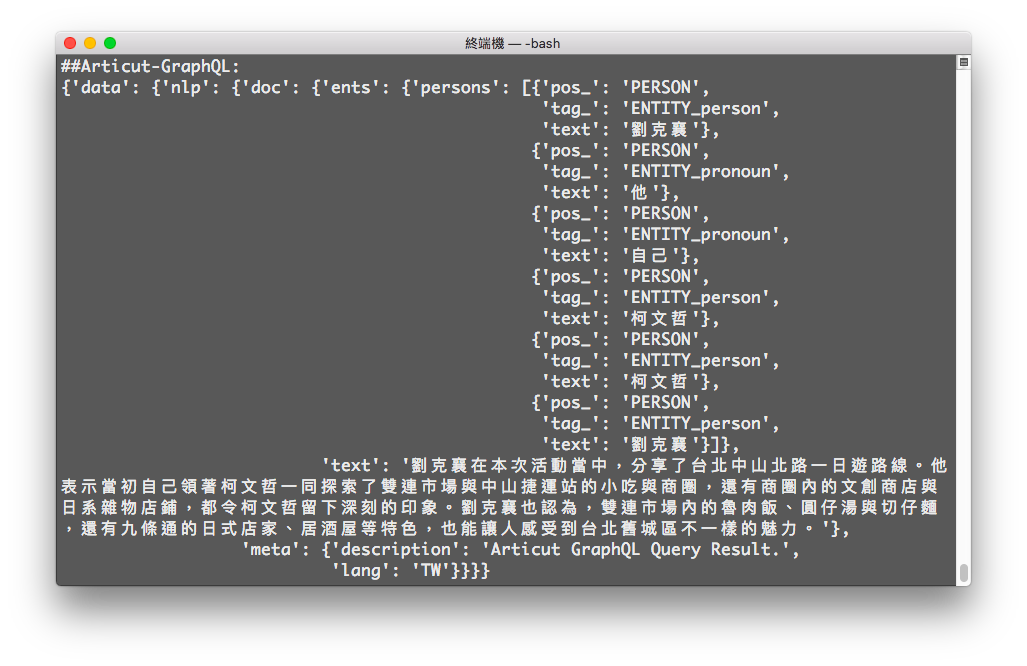| 名稱 | ArticutAPI | MP_ArticutAPI | WS_ArticutAPI |
|---|---|---|---|
| 產品 | Online / Docker | Docker | Docker |
| 技術 | HTTP Request | MultiProcessing | WebSocket |
| 特色 | 簡單易用 | 批次處理 | 即時處理 |
| 適用情景 | 任何 | 文本分析 | 聊天機器人 |
| 名稱 | ArticutAPI | MP_ArticutAPI | WS_ArticutAPI |
|---|---|---|---|
| 時間 | 0.1252 秒 | 0.1206 秒 | 0.0677 秒 |
| 句數 | ArticutAPI | MP_ArticutAPI | WS_ArticutAPI |
|---|---|---|---|
| 方法 | parse() | bulk_parse(20) | parse() |
| 1K | 155 秒 | 8 秒 | 18 秒 |
| 2K | 306 秒 | 14 秒 | 35 秒 |
| 3K | 455 秒 | 17 秒 | 43 秒 |
- 測試平台爲 4 核心 CPU 並使用 4 個 Process。
MP_ArticutAPI使用 bulk_parse(bulkSize=20) 方法。WS_ArticutAPI使用 parse() 方法。
pip3 install ArticutAPI函數說明請參閱 Docs/index.html
from ArticutAPI import Articut
from pprint import pprint
username = "" #這裡填入您在 https://api.droidtown.co 使用的帳號 email。若使用空字串,則預設使用每小時 2000 字的公用額度。
apikey = "" #這裡填入您在 https://api.droidtown.co 登入後取得的 api Key。若使用空字串,則預設使用每小時 2000 字的公用額度。
articut = Articut(username, apikey)
inputSTR = "會被大家盯上,才證明你有實力。"
resultDICT = articut.parse(inputSTR)
pprint(resultDICT)
{"exec_time": 0.06723856925964355,
"level": "lv2",
"msg": "Success!",
"result_pos": ["<MODAL>會</MODAL><ACTION_lightVerb>被</ACTION_lightVerb><ENTITY_nouny>大家</ENTITY_nouny><ACTION_verb>盯上</ACTION_verb>",
",",
"<MODAL>才</MODAL><ACTION_verb>證明</ACTION_verb><ENTITY_pronoun>你</ENTITY_pronoun><ACTION_verb>有</ACTION_verb><ENTITY_noun>實力</ENTITY_noun>",
"。"],
"result_segmentation": "會/被/大家/盯上/,/才/證明/你/有/實力/。/",
"status": True,
"version": "v118",
"word_count_balance": 9985,
"product": "https://api.droidtown.co/product/",
"document": "https://api.droidtown.co/document/"
}
可以依需求找出「名詞」、「動詞」或是「形容詞」…等詞彙語意本身已經完整的詞彙。
inputSTR = "你計劃過地球人類補完計劃"
resultDICT = articut.parse(inputSTR, level="lv1")
pprint(resultDICT["result_pos"])
#列出所有的 content word.
contentWordLIST = articut.getContentWordLIST(resultDICT)
pprint(contentWordLIST)
#列出所有的 verb word. (動詞)
verbStemLIST = articut.getVerbStemLIST(resultDICT)
pprint(verbStemLIST)
#列出所有的 noun word. (名詞)
nounStemLIST = articut.getNounStemLIST(resultDICT)
pprint(nounStemLIST)
#列出所有的 location word. (地方名稱)
locationStemLIST = articut.getLocationStemLIST(resultDICT)
pprint(locationStemLIST)
#resultDICT["result_pos"]
["<ENTITY_pronoun>你</ENTITY_pronoun><ACTION_verb>計劃</ACTION_verb><ASPECT>過</ASPECT><LOCATION>地球</LOCATION><ENTITY_oov>人類</ENTITY_oov><ACTION_verb>補完</ACTION_verb><ENTITY_nounHead>計劃</ENTITY_nounHead>"]
#列出所有的 content word.
[[(47, 49, '計劃'), (117, 119, '人類'), (146, 147, '補'), (196, 198, '計劃')]]
#列出所有的 verb word. (動詞)
[[(47, 49, '計劃'), (146, 147, '補')]]
#列出所有的 noun word. (名詞)
[[(117, 119, '人類'), (196, 198, '計劃')]]
#列出所有的 location word. (地方名稱)
[[(91, 93, '地球')]]
resultDICT = articut.versions()
pprint(resultDICT)
{"msg": "Success!",
"status": True,
"versions": [{"level": ["lv1", "lv2"],
"release_date": "2019-04-25",
"version": "latest"},
{"level": ["lv1", "lv2"],
"release_date": "2019-04-25",
"version": "v118"},
{"level": ["lv1", "lv2"],
"release_date": "2019-04-24",
"version": "v117"},...
}
inputSTR = "小紅帽"
resultDICT = articut.parse(inputSTR, level="lv1")
pprint(resultDICT)
極致斷詞,適合 NLU 或機器自動翻譯使用。呈現結果將句子中的每個元素都儘量細分出來。
{"exec_time": 0.04814624786376953,
"level": "lv1",
"msg": "Success!",
"result_pos": ["<MODIFIER>小</MODIFIER><MODIFIER_color>紅</MODIFIER_color><ENTITY_nounHead>帽</ENTITY_nounHead>"],
"result_segmentation": "小/紅/帽/",
"status": True,
"version": "v118",
"word_count_balance": 9997,...}
詞組斷詞,適合文本分析、特徵值計算、關鍵字擷取…等應用。呈現結果將以具意義的最小單位呈現。
{"exec_time": 0.04195523262023926,
"level": "lv2",
"msg": "Success!",
"result_pos": ["<ENTITY_nouny>小紅帽</ENTITY_nouny>"],
"result_segmentation": "小紅帽/",
"status": True,
"version": "v118",
"word_count_balance": 9997,...}
因為 Articut 只處理「語言知識」而不處理「百科知識」。 我們提供「使用者自定義」詞彙表的功能,使用 Dictionary 格式,請自行編寫。
UserDefinedFile.json
{"雷姆":["小老婆"],
"艾蜜莉亞":["大老婆"],
"初音未來": ["初音", "只是個軟體"],
"李敏鎬": ["全民歐巴", "歐巴"]}
runArticut.py
from ArticutAPI import Articut
from pprint import pprint
articut = Articut()
userDefined = "./UserDefinedFile.json"
inputSTR = "我的最愛是小老婆,不是初音未來。"
# 使用自定義詞典
resultDICT = articut.parse(inputSTR, userDefinedDictFILE=userDefined)
pprint(resultDICT)
# 未使用自定義詞典
resultDICT = articut.parse(inputSTR)
pprint(resultDICT)
# 使用自定義詞典
{"result_pos": ["<ENTITY_pronoun>我</ENTITY_pronoun><FUNC_inner>的</FUNC_inner><ACTION_verb>最愛</ACTION_verb><AUX>是</AUX><UserDefined>小老婆</UserDefined>",
",",
"<FUNC_negation>不</FUNC_negation><AUX>是</AUX><UserDefined>初音未來</UserDefined>",
"。"],
"result_segmentation": "我/的/最愛/是/小老婆/,/不/是/初音未來/。/",...}
# 未使用自定義詞典
{"result_pos": ["<ENTITY_pronoun>我</ENTITY_pronoun><FUNC_inner>的</FUNC_inner><ACTION_verb>最愛</ACTION_verb><AUX>是</AUX><ENTITY_nouny>小老婆</ENTITY_nouny>",
",",
"<FUNC_negation>不</FUNC_negation><AUX>是</AUX><ENTITY_nouny>初音</ENTITY_nouny><TIME_justtime>未來</TIME_justtime>",
"。"],
"result_segmentation": "我/的/最愛/是/小老婆/,/不/是/初音/未來/。/",...}
政府開放平台中存有「交通部觀光局蒐集各政府機關所發佈空間化觀光資訊」。Articut 可取用其中的資訊,並標記為 <KNOWLEDGE_place>
上傳內容 (JSON 格式)
{
"username": "test@email.com",
"api_key": "anapikeyfordocthatdoesnwork@all",
"input_str": "花蓮的原野牧場有一間餐廳",
"version": "v137",
"level": "lv1",
"opendata_place": true
}
回傳內容 (JSON 格式)
{
"exec_time": 0.013453006744384766,
"level": "lv1",
"msg": "Success!",
"result_pos": ["<LOCATION>花蓮</LOCATION><FUNC_inner>的</FUNC_inner><KNOWLEDGE_place>原野牧場</KNOWLEDGE_place><ACTION_verb>有</ACTION_verb><ENTITY_classifier>一間</ENTITY_classifier><ENTITY_noun>餐廳</ENTITY_noun>"],
"result_segmentation": "花蓮/的/原野牧場/有/一間/餐廳/",
"status": True,
"version": "v137",
"word_count_balance": 99987
}
- articut.analyse.extract_tags(sentence, topK=20, withWeight=False, allowPOS=())
- sentence 為要提取關鍵詞的文本
- topK 為提取幾個 TF-IDF 的關鍵詞,預設值為 20
- withWeight 為是否返回關鍵詞權重值,預設值為 False
- allowPOS 僅抽取指定詞性的詞,預設值為空,亦即全部抽取
- articut.analyse.TFIDF(idf_path=None) 新建 TFIDF 物件,idf_path 為 IDF 語料庫路徑
使用範例: https://github.com/Droidtown/ArticutAPI/blob/master/ArticutAPI.py#L624
- articut.analyse.textrank(sentence, topK=20, withWeight=False, allowPOS=())
- sentence 為要提取關鍵詞的文本
- topK 為提取幾個 TF-IDF 的關鍵詞,預設值為 20
- withWeight 為是否返回關鍵詞權重值,預設值為 False
- allowPOS 僅抽取指定詞性的詞,預設值為空,亦即全部抽取
- articut.analyse.TextRank() 新建 TextRank 物件
算法論文:TextRank: Bringing Order into Texts
- 將待抽取關鍵詞的文本斷詞
- 以固定的窗格大小 (預設值為 5,通過 span 屬性調整),詞之間的共現關係,建構出不帶權圖
- 計算途中節點的 PageRank
使用範例: https://github.com/Droidtown/ArticutAPI/blob/master/ArticutAPI.py#L629
環境需求
Python 3.6.1
$ pip install graphene
$ pip install starlette
$ pip install jinja2
$ pip install uvicorn
執行 ArticutGraphQL.py 帶入 Articut 斷詞結果檔案路徑,並開啟瀏覽器輸入網址 http://0.0.0.0:8000/
$ python ArticutGraphQL.py articutResult.json
安裝 graphene 模組
$ pip install graphene
inputSTR = "地址:宜蘭縣宜蘭市縣政北七路六段55巷1號2樓"
result = articut.parse(inputSTR)
with open("articutResult.json", "w", encoding="utf-8") as resultFile:
json.dump(result, resultFile, ensure_ascii=False)
graphQLResult = articut.graphQL.query(
filePath="articutResult.json",
query="""
{
meta {
lang
description
}
doc {
text
tokens {
text
pos_
tag_
isStop
isEntity
isVerb
isTime
isClause
isKnowledge
}
}
}""")
pprint(graphQLResult)
inputSTR = "劉克襄在本次活動當中,分享了台北中山北路一日遊路線。他表示當初自己領著柯文哲一同探索了雙連市場與中山捷運站的小吃與商圈,還有商圈內的文創商店與日系雜物店鋪,都令柯文哲留下深刻的印象。劉克襄也認為,雙連市場內的魯肉飯、圓仔湯與切仔麵,還有九條通的日式店家、居酒屋等特色,也能讓人感受到台北舊城區不一樣的魅力。"
result = articut.parse(inputSTR)
with open("articutResult.json", "w", encoding="utf-8") as resultFile:
json.dump(result, resultFile, ensure_ascii=False)
graphQLResult = articut.graphQL.query(
filePath="articutResult.json",
query="""
{
meta {
lang
description
}
doc {
text
ents {
persons {
text
pos_
tag_
}
}
}
}""")
pprint(graphQLResult)






